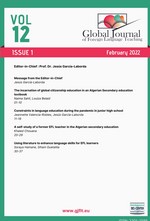Code-switching in English classrooms and its Impact on undergraduate learning in a public university in Afghanistan
Code-switching in English classrooms and its Impact on undergraduate learning in a public university in Afghanistan
Author(s): Hashmat TareenSubject(s): Foreign languages learning, Higher Education , ICT Information and Communications Technologies, Distance learning / e-learning, Pedagogy
Published by: Birlesik Dunya Yenilik Arastirma ve Yayincilik Merkezi
Keywords: Code-switching; EFL; EFL classroom; language;
Summary/Abstract: The alternate use of two different languages as code-switching is situated in the field of bilingualism and it is considered a common feature of those who speak two or more languages. The occurrence of code-switching in English classrooms is considered a conducive linguistic resource to be exploited and practiced sensibly. This study aims to highlight the current situation of code-switching in EFL classrooms, the motives for EFL lecturers’ code-switching during their instruction to facilitate the teaching and learning process, and the measures for avoiding the use of code-switching. A qualitative study based on interviews followed by classroom observation was conducted. Eight EFL learners in a public university participated in this study. Four instructional periods of classroom observations were carried out. The results indicated that code-switching is predominantly employed and learners perceive it positively and lecturers use it for content clarification and building rapport with learners. Moreover, it can be also considered as impeding language skills.
Journal: Global Journal of Foreign Language Teaching
- Issue Year: 12/2022
- Issue No: 2
- Page Range: 95-111
- Page Count: 17
- Language: English

